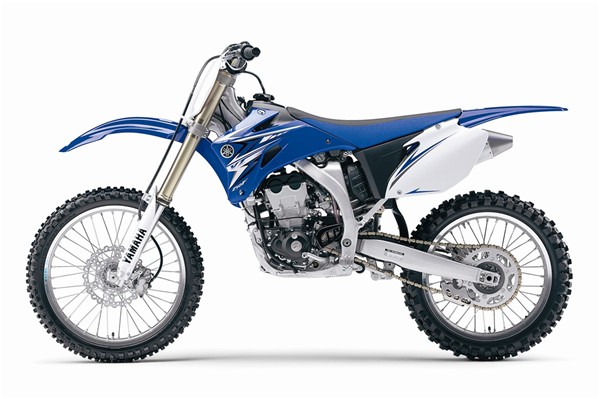MXPTV (Moto Xposure TV) is making its 4th visit to the Ricky Carmichael Daytona Amateur Supercross Championship on March 10-11 and for 2013, we are going live for the first time ever and we’re doing it right at the world center of racing from the infield at Daytona International Speedway. MXPTV will be producing a live race show recapping the event’s highlights on Sunday night, March 10th at 8pm ET. This marks not just a first for the Ricky Carmichael Daytona Amateur Supercross Championship to offer live streaming from the event but this will be the first event in the sport of motocross to be streamed live on YouTube, the world’s largest online video platform.
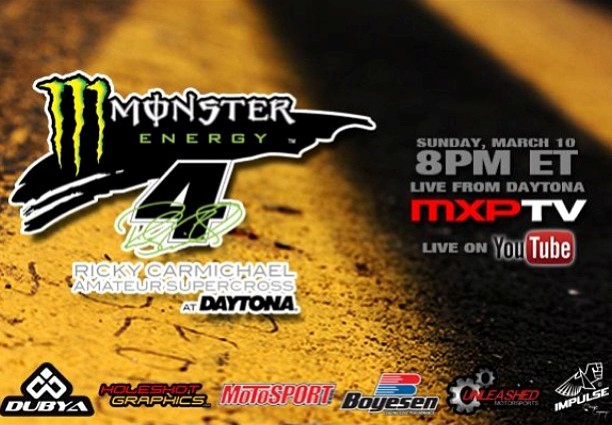
The August 2008 issue of Motocross Action magazine contains a test of a 250 two stroke versus a 250 four stroke. The following is the text of that test.
Rule changes made the fourstroke what it is today. Without the AMA four-stroke exemption rule of 1998, the modern four-stroke would still be defined by the Honda XR600.
Forget about EPA rules (they don’t affect closed-course racing machines), fleet fuel averages (they don’t apply to offroad bikes), cost savings (four-strokes cost more to produce) or any of the other hokey reasons that the nattering nabobs of negativity blame the rise of the fourstroke on. None of those things are players.
The AMA rule change was the impetus for the switch (followed by significant bike sales for the 1998 Yamaha YZ400—which led every other manufacturer to jump into building four-stroke motocross bikes).
No rule, no sales. No sales, no fourstrokes.
Originally, 250cc two-strokes were supposed to compete against 450cc four-strokes. On paper it’s not that good a match, with horsepower, torque and powerbands falling on the side of the thumper. Eventually, the factory race teams came to the realization, egged on by the sales departments, that they needed to go all four-stroke all the time.
The last competitive twostroke rider on the AMA circuit was James Stewart. He was still winning motos as
late as 2006 on a KX250, but by midseason he made the switch to four-strokes.
As it stands right now, only Yamaha and KTM still produce twostrokes for the masses. It was a little shocking that the AMA powers-thatbe sat on their hands from 1998 to 2008 before doing something to save
the two-stroke—and even then it wasn’t at the professional level.
For 2008, a 250cc two-stroke is legal to race in the same class as a 250cc four-stroke at the amateur level. It’s too little, too late, but at least it gives diehard two-stroke riders one last chance to show what would happen if the displacement advantage of fourstrokes was erased from the rule books (the equivalent rule would be for 450cc two-strokes to race against 450 four-strokes, but that rule doesn’t exist because the two-stroke bikes to fill that void don’t exist).
The MXA wrecking crew has tons of two- and four-stroke experience, so it was only natural that we answer
the question that every AMA amateur is asking. Which is better?
A YZ250 or YZ250F?
Q:WHICH BIKE COSTS THE MOST?
A:The Manufacturers Suggested Retail Price (MSRP) for a 2008 YZ250 two-stroke is $6399. MSRP for the 2008 YZ250F is $6249.
Q:WHAT’S THE DIFFERENCE BETWEEN THE YZ250 AND THE YZ250F?
A:The key difference between the YZ250 twostroke and the YZ250F is the engine. The rest of the changes are small setup differences in spring rates, chassis strength and geometry.
These changes stem from the fact that power output has a huge effect on how a bike handles, how the suspension works and what techniques the rider uses. The chassis must be compatible with the engine, and the rider must synchronize with the capabilities of the bike.
Q:WHICH BIKE MAKES THE MOST HORSEPOWER?
A:No comparison. A 2008 Yamaha YZ250F produces 36 horsepower at 11,300 rpm, while a YZ250 two-stroke makes 46.4 horsepower at 8500 rpm. That is a ten horsepower advantage at peak for the two-stroke.
Q:WHICH BIKE MAKES THE MOST TORQUE?
A:Pit pundits will always tell you that horsepower doesn’t matter as much as torque. They wax on about the torque advantage that a four-stroke engine has over a twostroke.
Guess what? A YZ250F fourstroke makes 20.1 foot-pounds of torque. Are you ready? A YZ250 twostroke pumps out 30.6 foot-pounds. For comparison purposes, a 450 fourstroke produces approximately 34 foot-pounds.
Q:WHICH BIKE HAS THE BEST POWERBAND?
A:Although the displacement of the two blue 250s is the same, the powerbands are apples and oranges.
YZ250 two-stroke: For a twostroke, the YZ250 has a very broad and usable powerband. But by fourstroke standards the power is peaky. The snappy throttle response and explosive hit allow a YZ250 racer to
make cuts and take lines that a four-stroke could never get to. In some conditions the YZ250 two-stroke powerband is phenomenal. In others it has a tendency to spin the rear tire, wheelie out of corners and wiggle on the exit.
YZ250F four-stroke: In back-to back races with the YZ250, the YZ250F engine feels slow. The hit is less pronounced, there is no wheelspin, and the wiggle is reduced to a quiver. But the feel of the YZ250F in comparison to the YZ250 is misleading.
The lack of a sensation of speed isn’t the same as an actual lack of speed. The powerband may be down ten horsepower, but it puts everything it’s got into the ground. It can be chugged. It can be lugged. And it can be revved until the cows come home. The 13,500 rpm rev limiter and 11,300 rpm peak are about 3500 rpm higher and wider than the twostroke’s working spread.
The choice: There is no doubt that the slower feeling, but broader and higher-revving powerband of the YZ250F is easier to work with than the gun-and-run hit of the YZ250 two-stroke.
Q:WHICH ONE IS FASTER?
A:Going fast may not always be about sheer horsepower, but in perfect conditions, horsepower will win out. In a straight line, the YZ250 two-stroke gets from one end of the line to the other end quicker. Much quicker. But all is not lost for the YZ250F.
Motocross is not drag racing. It doesn’t take place on asphalt. There is no rubber-soaked launch pad at the start of every straight. There are certain conditions when the slower, but higher revving YZ250F can actually go faster over a given distance than its two-stroke competitor.
Q:WHICH BIKE PRODUCES THE BEST LAP TIMES?
A:Although MXA had a wide range of test riders spend time on both bikes, we left all lap time testing to a single rider. We picked a 20-something Intermediate test rider because he was old enough to have raced a 250cc two-stroke and yet not immune to the charms of a fourstroke. When we examined his lap times, taken from actual races, not hot laps, we weren’t surprised to discover that his lap times on both the two-stroke and four-stroke were almost identical.
Depending on the track layout (hills, sand, whoops, jumps and hard pack) there were some deviations—but not enough to write home about. On tracks where horsepower paid big dividends, the fastest single lap time came on the YZ250 two-stroke. But on long tracks with harder dirt, the slowest lap time was also produced by the YZ250 two-stroke.
Why? In the test rider’s opinion, the YZ250 two-stroke was more of a crap shoot to ride, in that sometimes it was so brilliant out of berms and across rough ground that it seemed effortless. Yet the YZ250 two-stroke was also a lot easier to make mistakes on, and those mistakes produced erratic lap times. The YZ250F never set the fastest time, but then it never set the slowest time either. Across the board, if an MXA test rider could turn in a 2:35 on the YZ250, he could back it up with a 2:35 on the YZ250F in the next moto.
Q:WHAT CONDITIONS FAVOR EACH BIKE?
A:Slick conditions, where traction is limited and throttle control optimized, give the YZ250F the upper hand. The same held true in off-cambers and whoop sections with smallish humps. Every test rider believed that the steady throttle approach of the YZ250F four-stroke made the bike hook up better in tricky situations. Equally important for riders at tracks with concrete starting pads, the YZ250F could get off the line quicker. Unfortunately, the YZ250 two-stroke could use its extra ponies to run it down if the start was long enough.
When the dirt was good, there was a lot of sand, the hills were steep and the whoops were big, the YZ250 two-stroke shone. The twostroke literally exploded out of the soft corners that the YZ250F labored through. The tighter the turns and the deeper the dirt, the better the YZ250 was.
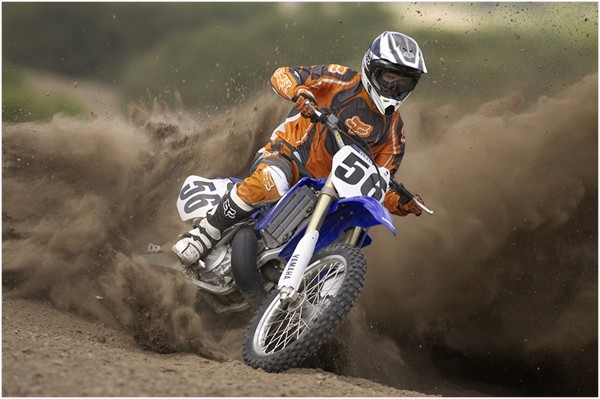
Q:WHICH ONE IS EASIER TO RIDE?
A:The YZ250F is easier to ride. When the rider twists the throttle of the Yamaha YZ250F, the power builds smoothly. Four-stroke power is broad and forgiving, and since the bike can rev forever, the rider doesn’t have to worry as much about shift points.
A corollary to this is that a bike with less horsepower can be ridden closer to its full potential, while a powerful bike doesn’t always get taken to the limit—thus the extra horses often go to waste.
Q:WHICH ONE IS EASIER TO RACE?
A:We aren’t talking about riding—-we are talking about racing against an angry pack of competitors. In these situations, the YZ250 two-stroke is the easier bike to put to its full use. A YZ250 rider, especially if he is in the midst of a pack of four-strokes, has many options available to him. He can go where the four-strokes can’t. A twostroke rider can dive bomb the inside without fear of the long spool up that a four-stroke rider has to worry about. A twostroke rider can bury the front into a berm and still break off at an extremely sharp angle.
Not so for the YZ250F rider. The YZ250F is at its best when the rider carries speed through the turns and flows around the track. This is fine for talented Intermediate and Pro riders, but Beginners and Novices tend to race to the corners more than through them. If the YZ250F gets its momentum broken, it takes time to get it steaming again. One truth about a conga line of four-strokes is that everyone is going to the exact same place—there is an optimum four-stroke line and no one wants to get off it.
A two-stroke isn’t so tightly bound to the good line. It can make cuts and with just a touch of the clutch be back up to speed. The explosive 250 two-stroke’s ability to make sharp turns and quick line changes makes it easier to race for the majority of riders. One caveat: If you don’t respect the explosive power of the two-stroke, you’ll soon find yourself tumbling down the track like a monkey in a dryer.
Q:WHICH BIKE IS EASIER TO START?
A:The YZ250. The YZ250F requires a little less leg strength to turn the engine over. It likes a smooth kick of the full stroke of the kick lever. The YZ250 two-stroke doesn’t need a full kick, and the moon and the stars don’t need to be properly aligned for it to fire. Hot or cold, whiskey throttle, after a crash, the two-stroke will always re-ignite. Not so with the four-stroke.
Q:WHICH BIKE WEIGHS THE LEAST?
A:They both weigh approximately 216 pounds. Two-stroke engines are lighter, but the extra horsepower means that the other components must be beefed up.
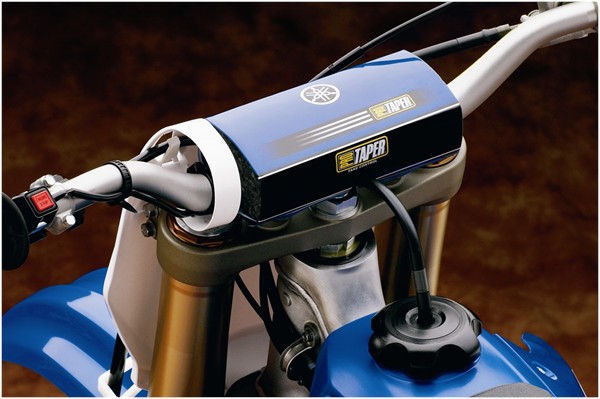
Q:WHICH BIKE HAS THE BEST HANDLING?
A:Both machines have their own distinct handling advantages.
YZ250 two-stroke: The snappy power of the two-stroke has more of a tendency to lift the front wheel, break traction and spin the rear tire. As a result, the bike turns from the rear. It likes to power slide and explode out of turns. In soft dirt and loam, the two-stroke gets on top of the dirt much quicker than the YZ250F. It’s more willing to make quick direction changes and switch lines on a whim. YZ250 two-stroke riders are rewarded for seeking out good dirt and taking the bull by the horns. Although the weight of the bikes is the same, the power delivery of the two-stroke makes it feel lighter.
YZ250F: The YZ250F mill only produces power every other revolution. This produces a smooth torque curve that drives the bike forward with much more weight on the front wheel. The YZ250F is a front-wheel handler that likes to be steered around turns. The power doesn’t come on quickly, it builds over time. It’s more prone to coming out of corners like a road racer. YZ250F riders are rewarded by planning ahead, making nice arcing turns, and carrying speed. The YZ250F is much more planted to the ground, and when the rider makes mistakes, things happen a bit more slowly.
Q:WHICH BIKE HAS THE BEST SUSPENSION?
A:The YZ250. The suspension components of each bike are identical—given their differing setups. However, the different powerbands work the suspension a bit differently. The quicker power of the two-stroke is more likely to put a spiking load on the rear suspension under acceleration, and the lack of engine compression allows it to enter bumpy corners without a lot of wheel hop. Logic dictates that the setup for the same rider would have a bit more high-speed compression and a bit quicker rebound in the rear of the two-stroke.
Q:WHICH BIKE IS EASIER TO MAINTAIN?
A:The two-stroke naturally goes through tires, brakes pads, chains and sprockets a bit faster because it makes more power. But the complexity of the four-stroke engine makes it an expensive proposition to live with. It needs oil, oil filters and eventual valve work that the two-stroke can do without.
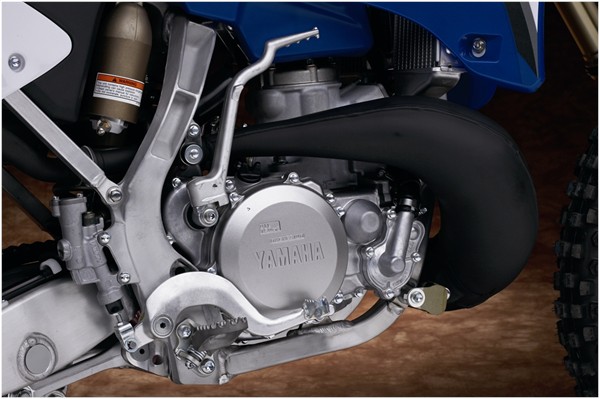
Q:WHAT ABOUT ENGINE REBUILDS?
A:Puhleeze! Two-stroke engines are easier to rebuild, have fewer parts, and the parts cost less. That recipe means that you could rebuild a YZ250 three or four times for the cost of one rebuild on the YZ250F. Don’t even think about the cost of a catastrophic failure on a four-stroke engine.
Q:WHAT’S THE FINAL WORD?
A:The MXA wrecking crew doesn’t want you to run out and buy the bike that we think is the winner. We want you to look at the strengths and weaknesses of the YZ250 and YZ250F and look at your personal strengths and weaknesses. Logic says that since lap times are virtually identical for the same rider on both bikes, that the real difference comes down to the battle of ten extra horsepower over an easier to-ride chassis.
For a racer, starting on a typical dirt starting line, the YZ250 two-stroke should always get the holeshot. If the 250cc two-stroke doesn’t beat a 250cc four-stroke to the first turn, the rider should retire and take up mushroom farming. The YZ250F just can’t overcome the ten horsepower disadvantage in the first 200 feet. From that point on, it’s a matter of whether the track has the kind of conditions that will force the two-stroke rider into making a mistake. If he doesn’t, he will keep the lead to the checkered flag.
Does that mean that the starting gates are going to fill up with YZ250 two-stroke riders? No. The average 250 Novice or Intermediate has no 250cc two-stroke experience, and it will cost him $6399 to get a YZ250 two-stroke to gain that know-how. For most riders, with average talent, the difference won’t be worth the extra cost.
Now if we are talking a 250 twostroke versus a 450 four-stroke, all bets are off. ?
http://www.motocrossactionmag.com
Motocross Action supports two strokes and tells it like it is. Please support them by subscribing to their great magazine. I get the digital version and it’s awesome.


